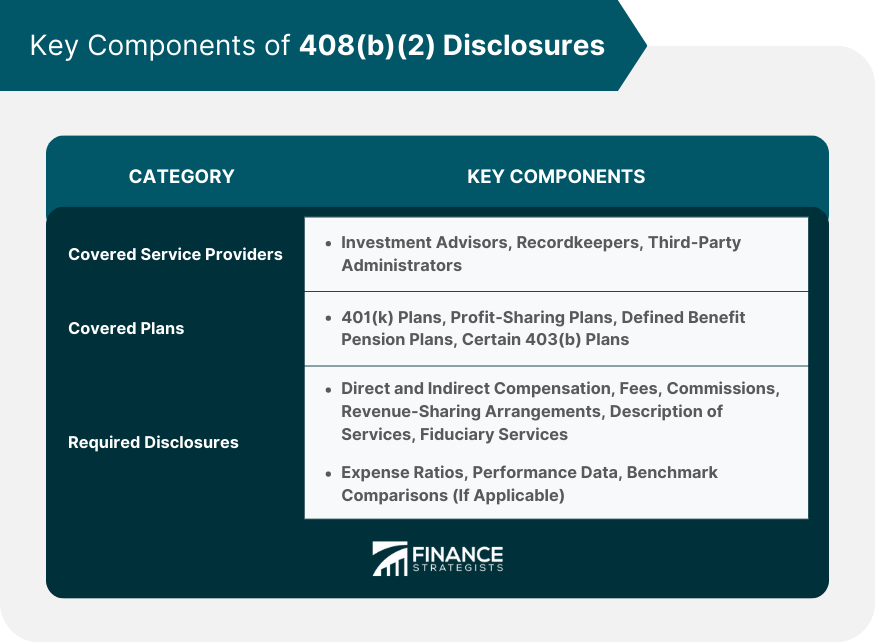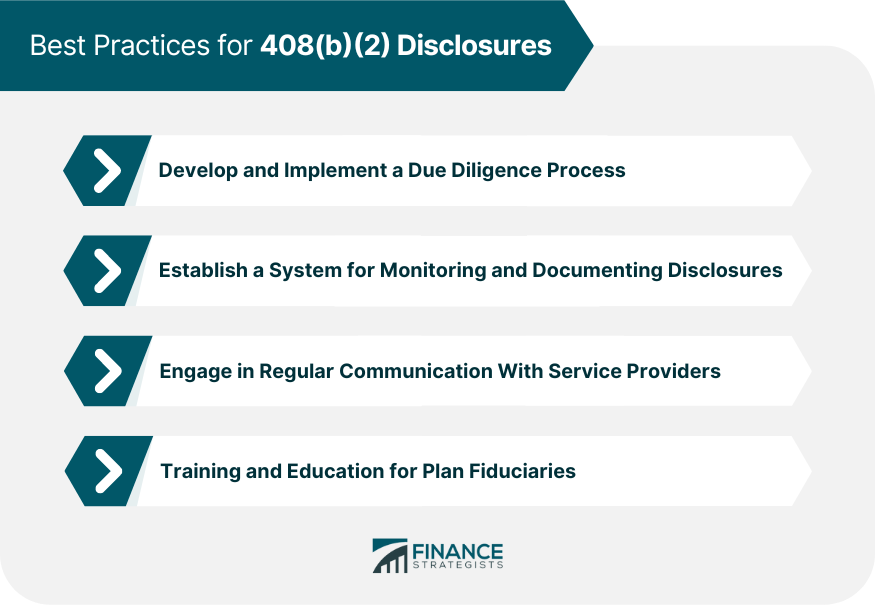Section 408(b)(2) of the Employee Retirement Income Security Act (ERISA) requires covered service providers to disclose specific information about their compensation, services, and investments to plan fiduciaries. The purpose of these disclosures is to help fiduciaries make informed decisions when selecting and monitoring service providers, thereby ensuring the reasonableness of fees and services provided to retirement plans. 408(b)(2) Disclosures is a regulation by the DOL under ERISA. Compliance with 408(b)(2) disclosure requirements is crucial for fiduciaries and service providers alike. Fiduciaries must ensure that they receive, review, and assess these disclosures to fulfill their obligations under ERISA, while service providers must provide complete and accurate information to maintain their status as covered providers. The 408(b)(2) disclosure requirements apply to service providers who enter into a contract or arrangement with a covered plan and receive $1,000 or more in direct or indirect compensation. Covered service providers include, but are not limited to, investment advisors, recordkeepers, and third-party administrators. The disclosure requirements apply to ERISA-covered retirement plans, such as 401(k) plans, profit-sharing plans, defined benefit pension plans, and certain 403(b) plans. Covered service providers must disclose their direct and indirect compensation, including fees, commissions, and revenue-sharing arrangements. This information helps plan fiduciaries assess the reasonableness of the fees charged to the plan and its participants. Service providers must describe the services they will provide to the plan, including any fiduciary services. This information enables fiduciaries to evaluate the scope and quality of the services offered. If applicable, service providers must disclose investment-related information, such as expense ratios, performance data, and benchmark comparisons. This information helps fiduciaries monitor and evaluate the plan's investment options. The 408(b)(2) regulations require service providers to furnish written disclosures to plan fiduciaries. This requirement ensures that fiduciaries have a clear and tangible record of the information they need to fulfill their duties under ERISA. Service providers may provide electronic disclosures if they meet certain conditions, such as ensuring that fiduciaries can readily access and retain the information. Electronic delivery offers convenience and efficiency while still complying with the written disclosure requirement. Covered service providers must provide initial disclosures before entering into a contract or arrangement with a plan. They must also provide ongoing disclosures whenever there are changes to the information previously disclosed or when new investment options are added. Service providers must inform plan fiduciaries of any changes to the previously disclosed information, including changes in fees, services, or investment-related information. This ensures that fiduciaries have up-to-date information to fulfill their obligations under ERISA. When there are material changes to the compensation or services provided, service providers must disclose these changes to plan fiduciaries as soon as reasonably possible, generally within 60 days of becoming aware of the change. This allows fiduciaries to reassess the reasonableness of the fees and services provided. Service providers must update investment-related disclosures when new investment options are added to the plan. This ensures that fiduciaries can properly evaluate the performance and fees associated with these new options. Plan fiduciaries must assess the reasonableness of the fees and services provided by covered service providers based on the information disclosed. This evaluation helps protect plan participants from excessive fees and ensures they receive appropriate services. Fiduciaries must monitor service providers to ensure they comply with 408(b)(2) disclosure requirements. This ongoing oversight helps protect the plan and its participants from potential non-compliance issues. Plan Fiduciaries should maintain thorough documentation of their evaluation and selection process for service providers. This documentation serves as evidence that fiduciaries have fulfilled their duties under ERISA and can be crucial in the event of an audit or litigation. Failure to comply with 408(b)(2) disclosure requirements can result in a prohibited transaction under ERISA, leading to significant penalties and potential disqualification of the plan. Non-compliant service providers and plan fiduciaries may be subject to excise taxes and other penalties for their involvement in prohibited transactions. Plan participants, beneficiaries, and the DOL may initiate civil actions against non-compliant fiduciaries and service providers to recover losses or enforce compliance with ERISA. Plan fiduciaries should establish a comprehensive due diligence process to evaluate and select service providers. This process should include a thorough review of 408(b)(2) disclosures and other relevant factors, such as the provider's experience, reputation, and financial stability. Fiduciaries should implement a system for monitoring and documenting 408(b)(2) disclosures to ensure they receive and review all required information. This system can help fiduciaries demonstrate their compliance with ERISA and avoid potential penalties. Maintaining open lines of communication with service providers can help plan fiduciaries stay informed about any changes to fees, services, or investments. Regular communication also enables fiduciaries to address any concerns or issues promptly. Fiduciaries should stay informed about their responsibilities under ERISA, including 408(b)(2) disclosure requirements. Regular training and education can help fiduciaries remain up-to-date on regulatory developments and best practices. Transparency and disclosure are essential for protecting the interests of plan participants and ensuring the reasonableness of fees and services provided by retirement plans. The 408(b)(2) disclosure requirements play a crucial role in promoting transparency and helping fiduciaries make informed decisions when selecting and monitoring service providers. As the retirement plan landscape continues to evolve, it is essential for plan fiduciaries and service providers to stay informed about any changes to regulations, including 408(b)(2) disclosure requirements. Staying up-to-date on regulatory developments can help ensure ongoing compliance and protect the interests of plan participants. Ultimately, 408(b)(2) disclosures serve to safeguard the interests of retirement plan participants by promoting transparency, helping fiduciaries make informed decisions, and ensuring the reasonableness of fees and services provided. By understanding and complying with these disclosure requirements, fiduciaries and service providers can contribute to the overall health and success of retirement plans.Definition and Purpose of 408(b)(2) Disclosures
Importance for Retirement Plan Fiduciaries and Service Providers
Key Components of 408(b)(2) Disclosures

Covered Service Providers
Covered Plans
Required Disclosures
Compensation-Related Information
Services-Related Information
Investment-Related Information
Disclosure Format and Delivery
Written Disclosure
Electronic Disclosure
Timing of Initial and Ongoing Disclosures
Changes to 408
Notification of Changes to Service Providers
Material Changes to Compensation or Services
Updating Disclosures for New Investment Options
Fiduciary Responsibilities Related to 408(b)(2) Disclosures
Evaluating Reasonableness of Fees and Services
Monitoring Service Providers' Compliance
Documenting the Evaluation and Selection Process
Consequences of Non-compliance With 408(b)(2) Disclosures
Prohibited Transactions
Excise Taxes and Penalties
Potential Civil Actions
Best Practices for 408(b)(2) Disclosures

Developing and Implementing a Due Diligence Process
Establishing a System for Monitoring and Documenting Disclosures
Engaging in Regular Communication With Service Providers
Training and Education for Plan Fiduciaries
Final Thoughts
408(b)(2) Disclosures FAQs
The primary purposes of 408(b)(2) Disclosures are to promote transparency, help fiduciaries make informed decisions when selecting and monitoring service providers, and ensure the reasonableness of fees and services provided to retirement plans.
Covered service providers, including investment advisors, recordkeepers, and third-party administrators, who enter into a contract or arrangement with a covered plan and receive $1,000 or more in direct or indirect compensation, are required to provide 408(b)(2) Disclosures.
408(b)(2) Disclosures must include compensation-related information (such as fees, commissions, and revenue-sharing arrangements), services-related information (including descriptions of provided services and any fiduciary services), and investment-related information (if applicable, including expense ratios, performance data, and benchmark comparisons).
Plan fiduciaries should assess the reasonableness of fees and services provided by covered service providers based on the information disclosed in 408(b)(2) Disclosures. Fiduciaries must also monitor service providers to ensure their compliance with disclosure requirements and maintain thorough documentation of their evaluation and selection process.
Non-compliance with 408(b)(2) Disclosures can result in prohibited transactions, excise taxes, penalties, and potential civil actions against non-compliant fiduciaries and service providers. These consequences underscore the importance of understanding and adhering to 408(b)(2) disclosure requirements.
True Tamplin is a published author, public speaker, CEO of UpDigital, and founder of Finance Strategists.
True is a Certified Educator in Personal Finance (CEPF®), author of The Handy Financial Ratios Guide, a member of the Society for Advancing Business Editing and Writing, contributes to his financial education site, Finance Strategists, and has spoken to various financial communities such as the CFA Institute, as well as university students like his Alma mater, Biola University, where he received a bachelor of science in business and data analytics.
To learn more about True, visit his personal website or view his author profiles on Amazon, Nasdaq and Forbes.















